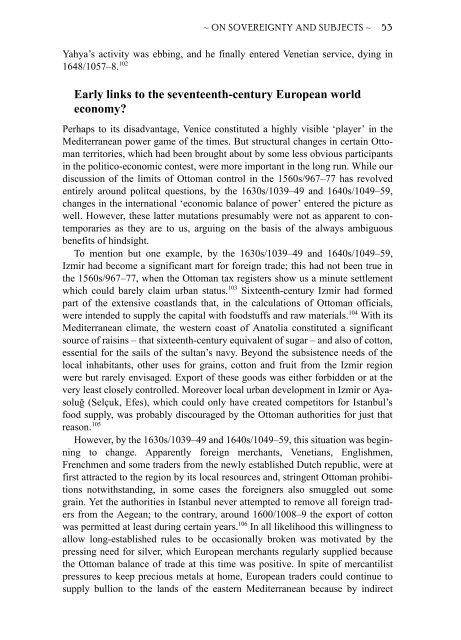The Ottoman Empire and the World Around It - Course Information
The Ottoman Empire and the World Around It - Course Information
The Ottoman Empire and the World Around It - Course Information
Create successful ePaper yourself
Turn your PDF publications into a flip-book with our unique Google optimized e-Paper software.
~ ON SOVEREIGNTY AND SUBJECTS ~ 53<br />
Yahya’s activity was ebbing, <strong>and</strong> he finally entered Venetian service, dying in<br />
1648/1057–8. 102<br />
Early links to <strong>the</strong> seventeenth-century European world<br />
economy?<br />
Perhaps to its disadvantage, Venice constituted a highly visible ‘player’ in <strong>the</strong><br />
Mediterranean power game of <strong>the</strong> times. But structural changes in certain <strong>Ottoman</strong><br />
territories, which had been brought about by some less obvious participants<br />
in <strong>the</strong> politico-economic contest, were more important in <strong>the</strong> long run. While our<br />
discussion of <strong>the</strong> limits of <strong>Ottoman</strong> control in <strong>the</strong> 1560s/967–77 has revolved<br />
entirely around politcal questions, by <strong>the</strong> 1630s/1039–49 <strong>and</strong> 1640s/1049–59,<br />
changes in <strong>the</strong> international ‘economic balance of power’ entered <strong>the</strong> picture as<br />
well. However, <strong>the</strong>se latter mutations presumably were not as apparent to contemporaries<br />
as <strong>the</strong>y are to us, arguing on <strong>the</strong> basis of <strong>the</strong> always ambiguous<br />
benefits of hindsight.<br />
To mention but one example, by <strong>the</strong> 1630s/1039–49 <strong>and</strong> 1640s/1049–59,<br />
Izmir had become a significant mart for foreign trade; this had not been true in<br />
<strong>the</strong> 1560s/967–77, when <strong>the</strong> <strong>Ottoman</strong> tax registers show us a minute settlement<br />
which could barely claim urban status. 103 Sixteenth-century Izmir had formed<br />
part of <strong>the</strong> extensive coastl<strong>and</strong>s that, in <strong>the</strong> calculations of <strong>Ottoman</strong> officials,<br />
were intended to supply <strong>the</strong> capital with foodstuffs <strong>and</strong> raw materials. 104 With its<br />
Mediterranean climate, <strong>the</strong> western coast of Anatolia constituted a significant<br />
source of raisins – that sixteenth-century equivalent of sugar – <strong>and</strong> also of cotton,<br />
essential for <strong>the</strong> sails of <strong>the</strong> sultan’s navy. Beyond <strong>the</strong> subsistence needs of <strong>the</strong><br />
local inhabitants, o<strong>the</strong>r uses for grains, cotton <strong>and</strong> fruit from <strong>the</strong> Izmir region<br />
were but rarely envisaged. Export of <strong>the</strong>se goods was ei<strong>the</strong>r forbidden or at <strong>the</strong><br />
very least closely controlled. Moreover local urban development in Izmir or Ayasoluğ<br />
(Selçuk, Efes), which could only have created competitors for Istanbul’s<br />
food supply, was probably discouraged by <strong>the</strong> <strong>Ottoman</strong> authorities for just that<br />
reason. 105<br />
However, by <strong>the</strong> 1630s/1039–49 <strong>and</strong> 1640s/1049–59, this situation was beginning<br />
to change. Apparently foreign merchants, Venetians, Englishmen,<br />
Frenchmen <strong>and</strong> some traders from <strong>the</strong> newly established Dutch republic, were at<br />
first attracted to <strong>the</strong> region by its local resources <strong>and</strong>, stringent <strong>Ottoman</strong> prohibitions<br />
notwithst<strong>and</strong>ing, in some cases <strong>the</strong> foreigners also smuggled out some<br />
grain. Yet <strong>the</strong> authorities in Istanbul never attempted to remove all foreign traders<br />
from <strong>the</strong> Aegean; to <strong>the</strong> contrary, around 1600/1008–9 <strong>the</strong> export of cotton<br />
was permitted at least during certain years. 106 In all likelihood this willingness to<br />
allow long-established rules to be occasionally broken was motivated by <strong>the</strong><br />
pressing need for silver, which European merchants regularly supplied because<br />
<strong>the</strong> <strong>Ottoman</strong> balance of trade at this time was positive. In spite of mercantilist<br />
pressures to keep precious metals at home, European traders could continue to<br />
supply bullion to <strong>the</strong> l<strong>and</strong>s of <strong>the</strong> eastern Mediterranean because by indirect


